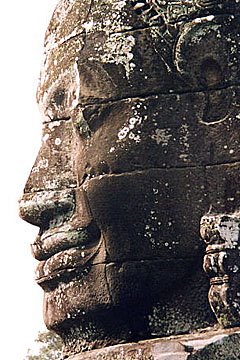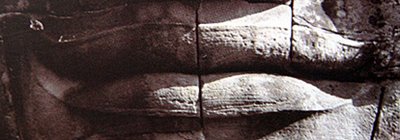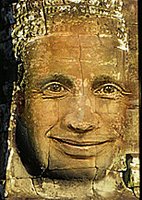The Smile of Angkor
 The 'Smile of Angkor' has captured the imagination of visitors for centuries. Each face is distinquished by; a broad forehead, downcast eyes, wide nostrils, thick lips curling upwards at the corners and a hint of a moustache. This is Pierre Loti's reaction when he saw the faces of the Bayon, taken from his 1902 book, Siam:
The 'Smile of Angkor' has captured the imagination of visitors for centuries. Each face is distinquished by; a broad forehead, downcast eyes, wide nostrils, thick lips curling upwards at the corners and a hint of a moustache. This is Pierre Loti's reaction when he saw the faces of the Bayon, taken from his 1902 book, Siam:I raise my eyes to look at the towers which overhand me, drowned in verdure, and I shudder suddenly with an indefinable fear as I perceive, falling upon me from above, a huge, fixed smile; and then another smile again, beyond, on another stretch of wall,...and then three, and then five and then ten. They appear everywhere, and I realize that I have been overlooked from all sides by the faces of the quadrupled-visaged towers....They are of a size, these masks carved in the air, so far exceeding human proportions that it requires a moment or two fully to comprehend them.
 This extract and many more in a similar vein can be found in a book by the author Dawn Rooney, called Angkor Observed, which was published by Orchid Press in 2001. It consists of a selection of early travellers' impressions of Angkor, most of which are out-of-print and found only in the archives of institutions or specialized libraries, so few people today know about the experiences and thoughts of these early visitors to Angkor. It's a fascinating guidebook companion to Angkor.
This extract and many more in a similar vein can be found in a book by the author Dawn Rooney, called Angkor Observed, which was published by Orchid Press in 2001. It consists of a selection of early travellers' impressions of Angkor, most of which are out-of-print and found only in the archives of institutions or specialized libraries, so few people today know about the experiences and thoughts of these early visitors to Angkor. It's a fascinating guidebook companion to Angkor.For those who have not visited the Bayon temple at the heart of the great city of Angkor Thom, I repeat a passage from Somerset Maugham's 1930 book, the Gentleman in the Parlour:
It surprised me because it had not the uniformity of the other temples I had seen. It consists of a multitude of towers one above the other, symmetrically arranged, and each tower is a four-faced, gigantic head of Siva the Destroyer. They stand in circles one within the other and the four faces of the god are surmounted by a decorated crown. In the middle is a great tower with face rising above face till the apex is reached. It is all battered by time and weather, creepers and parasitic shrubs grow all about, so that at a first glance you only see a shapeless mass and it is only when you look a little more closely that these silent, heavy, impassive faces loom out at you from the rugged stone. Then they are all around you. They face you, they are at your side, they are behind you, and you are watched by a thousand unseeing eyes. They seem to look at you from the remote distance of primeval time and all about you the jungle grows fiercely. You cannot wonder that the peasants when they pass should break into loud song in order to frighten away the spirits; for towards evening the silence is unearthly and the effect of all those serene and yet malevolent faces is eerie. When the night falls, the faces sink away into the stones and you have nothing but a strange, shrouded collection of oddly shaped turrets.

And finally, this is one face that you won't find at the Bayon. However, if you do, you must let me know! Stereo photographer and musician Robert Bloomberg gave his own tongue-in-cheek take on the origin of the Smile of Angkor when he sent me the above photograph in 2002. "A small tribute to your Buddha nature..." was how he phrased it at the time.


0 Comments:
Post a Comment
<< Home